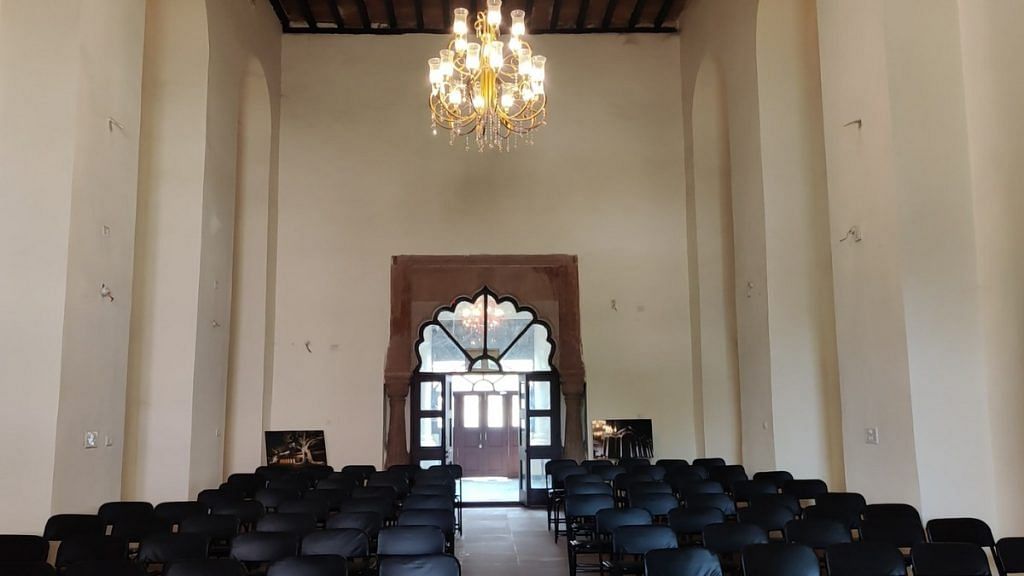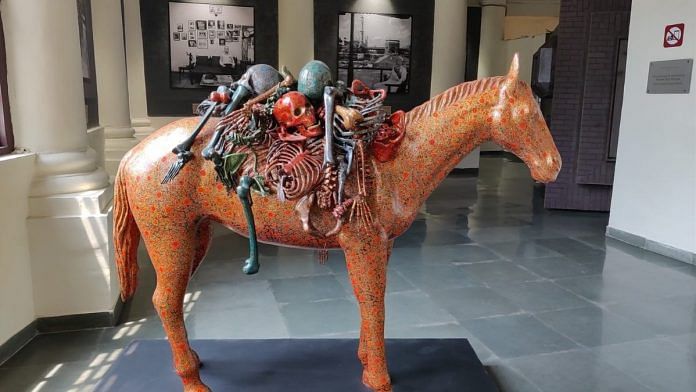New Delhi: The faded beige sari petticoat with a large tear down its side would not normally be worthy of a second look. But today it is a precious fragment of history, framed carefully in glass because of the powerful story it tells.
More than 75 years ago, in August 1947, a young woman was wearing this petticoat while travelling in a train during Partition. Her father, a doctor, was tending to injured passengers at the time. Without any bandages at hand, he asked her to tear a piece of cloth from her petticoat, now framed in Delhi’s Partition Museum, expected to open to the public soon.
Then there is a length of gorgeous embroidered Phulkari fabric. This cloth was said to have been given for safekeeping to a Delhi resident by a refugee. The owner reportedly said he’d be back to retrieve the cloth once he got some money, but he never returned.
The torn beige petticoat and the Phulkari fabric are just two among the many poignant exhibits, including letters, newspaper cuttings, and household items, at the museum. Most personal items have been donated by Partition survivors or their relatives.
Located within the iconic Dara Shikoh Library on the Kashmere Gate campus of Ambedkar University, the museum’s exhibits are ready but the date for opening is yet to be set, museum officials told ThePrint, noting that they have already received bookings for three school visits despite this.
They added that a maximum of 200 visitors will be permitted to visit in a day. While entry will be free for an unspecified time, a fee will eventually be charged; the amount is yet to be ascertained.
Upon entering the museum, one of the most arresting sights is a colourful papier-mâché horse made by Kashmiri artist Veer Munshi.
Speaking to ThePrint, Kishwar Desai, the chairperson of The Arts and Cultural Heritage Trust (TAACHT), which set up the museum, explained that the horse represents the “pain of migration”.
“From afar it looks like a beautiful papier-mâché horse, but when you come close you see bones and skulls. It conveys the impact of Partition and migration,” she added.
Also read: PMs’ Museum bedazzles and entertains. But it doesn’t tell us who we are
Six galleries, themes from loss to hope
The museum is divided into six galleries covering various distinct themes related to Partition and its aftermath.
“Towards Independence and Partition” presents the historical background leading up to Pakistan being carved out of India. “Migration” highlights the devastating exodus of people from both sides of the border, while the “Gallery of Refugees” and “Rebuilding Home” both focus on the settling down of the displaced, particularly in Delhi.
Finally, “Rebuilding Relationships” focuses on healing through reaching out, and a section called “Hope and Courage” features the stories of people who, despite losing everything, survived and thrived.
Peppered throughout each of these galleries are oral history screens — 28 in all — on which visitors can view recordings of people sharing their recollections of Partition and related events from the era.
A separate section called “Partition in the Mind of an Artist” exhibits artworks related to this period in history.
Notably, while many of the exhibits highlight the wrenching fallout of forced migration, the museum also brings out less prominent narratives, including those of people who did not move despite the tumult around them.
One wall displays pictures of people from Old Delhi who carried on living in their neighbourhood despite the communal unrest at the time.
Pointing at these photographs, Desai said: “They were living in Purani Dilli (Old Delhi), which was vastly impacted by the 1947 events and riots… these are the narratives of the Hindus, Muslims, and Christians who did not move. Some of them, of course, have divided families where some relatives moved to Pakistan, but they have led fairly contented lives.”
Other notable exhibits in the museum include a certificate that was given to a British officer (apparently along with Rs 25) for breaking up a Congress gathering and Jain idols brought from Multan by members of the community.
From Mughal library to Partition Museum
Built in 1637 by Dara Shikoh, the son of Mughal emperor Shah Jahan, the Dara Shikoh Library building has changed several hands over the centuries, eventually coming under the Delhi government, which undertook basic restoration work.

For its conversion into the Partition Museum, the building was entrusted to The Arts and Cultural Heritage Trust under the Union Ministry of Tourism’s ‘Adopt A Heritage’ scheme.
“There are three parties to Adopt A Heritage. One is the Ministry of Tourism, under which the scheme falls. The second party is us (TAACHT) of whom I am the chair. The third party is the Delhi government because this building comes under them. We are the ones given the responsibility to revamp it,” Kishwar Desai told ThePrint.
The idea of a Partition Museum in Delhi, to complement the existing one in Amritsar, started coming to fruition about three years ago, said museum director Ashwini Bahadur.
“The work continued throughout the Covid pandemic. Though there were financial issues, work did not stop,” she added.
(Edited by Asavari Singh)
Also read: Split by Partition, met in 2022: Story of brothers’ reunion



